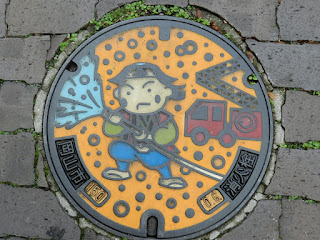Monday, 31 October 2016
Nishiki Market
Sunday, 30 October 2016
Kyoto Outing
Saturday, 29 October 2016
Nara
As we were on the Nara JR train line we decided to continue to Nara which was the capital of Japan from 710 to 784 when the framework of national government was consolidated. At the station we bought an all travel day pass for only 500 JPY (about $7) to use the terrific system of buses which efficiently takes thousands of visitors around the various sites. There are numerous historic monuments including Buddhist temples, Shinto shrines and the excavated remains of the Imperial Palace.
Our first stop was the Kohfukuji Buddhist Temple in Nara Park. We immediately saw the deer that roam the park in their hundreds. They are tame and are fed "deer biscuits" by visitors (at a cost of 150 JPY) but apparently they can be aggressive, which probably explains why their horns had been removed. Some deer have learned to bow to visitors to ask to be fed. One unsuccessfully tried to have a taste of Anita's coffee. They have been in the park for centuries and are protected as they are considered in Shinto to be messengers of the gods.
There is a five story wooden pagoda that is 50 metres tall. It was first built in 730, and was rebuilt in 1426. The timbers are fastened together with hardly any nails by inserting carved thinner and narrower ends of beams into slots. There are about a thousand large mortise joints in a five-story pagoda - that's a lot of carpentry!
The most outstanding place we saw today was the Buddhist Todaiji Temple. The Great Buddha Hall houses the world's largest gilded bronze statue of the Buddha at an impressive height of 15 metres. The temple is also the Japanese headquarters of the Kegon school of Buddhism.
Fushimi Inari Taisha Shrine
We caught a local train to Inari to see the Fushimi Inari Taisha Shrine which was just across the road from the station. This Shinto shrine is unique in having thousands of torii or gateways which are usually made of wood and painted black and orange (or vermillion). There are literally thousands of torii at the Fushimi Inari Shrine, most of which are over the paths up to a shrine at the top of Mount Inari. Each is donated by a Japanese business or individual at great expense.
We did not walk all the way up to the top as that would have taken about 2 hours. Fushimi Inari is the most important of several thousands of shrines dedicated to Inari, the Shinto god of rice. There are many pairs of statues of foxes who are thought to be Inari's messengers so many have things like a scroll in their mouths.
There were thousands of other tourists at the shrine, mostly Japanese. I finally managed to take one picture without there being dozens of other people in the frame.
Friday, 28 October 2016
Kyoto
The trip from our hotel to Kyoto was fairly straight forward as by now we are familiar with that section of the Osaka transport system. We changed our reserved seats for an earlier bullet train and 15 minutes later we were in Kyoto. Getting out of Kyoto Station was another matter – some of the stations in Japan are incredibly big, with all sorts of shops and restaurants, including high end dining.
Our hotel is only a 2 minute walk from the station so we parked our bags there and ventured on a very crowded bus to Gion which is one of the historic areas of Kyoto. The Yasaka Shrine was immediately opposite the bus stop so that was the first place we visited. Several of Kyoto's historic shrines and temples have been granted World Heritage status. We won't be here long enough to see all of them but some are very special. Initial construction of the Yasaka Shrine started in 656.
We had tempura for lunch and suffered another very crowded bus ride back to our hotel. Our room is small in comparison to hotels in Australia and other western countries, but it is serviceable. One of the hotel attractions is the hot spring communal bath, which fortunately is divided into male only and female only.


































